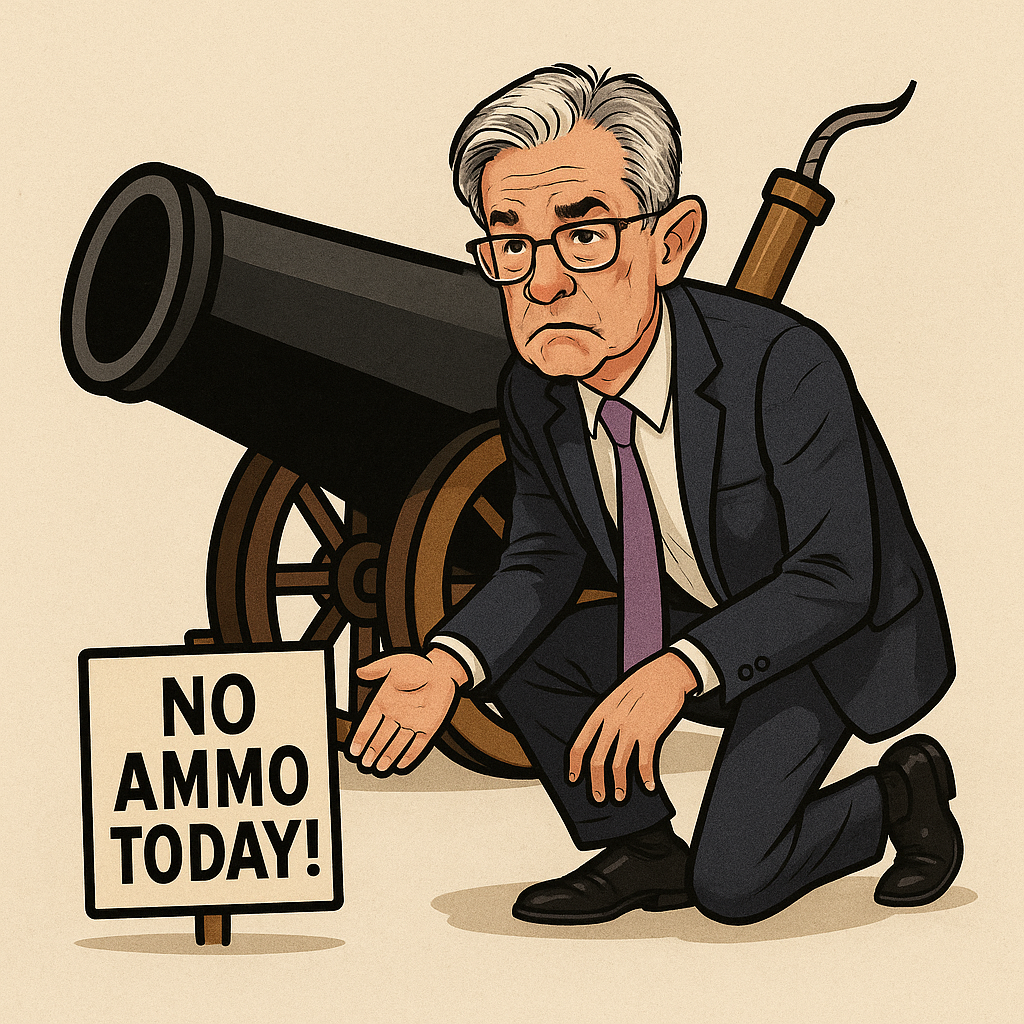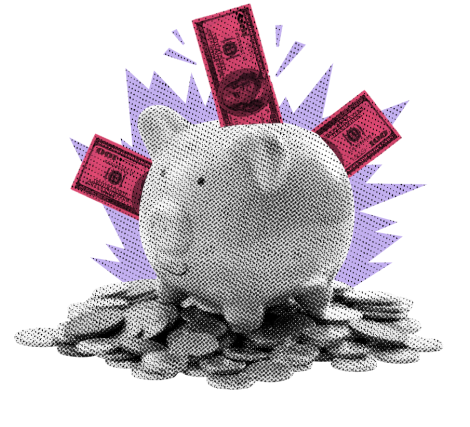
Powell warns of stagflation, but the Fed chooses to wait and watch. Here’s why.
KEY TAKEAWAYS
- Stagflation risk is now openly acknowledged by the Fed.
- Tariffs are causing both inflation and potential unemployment—classic supply-push dynamics.
- Interest rate policy is powerless against supply-driven inflation.
- The Fed’s inaction is a signal they’re stuck without tools.
- Rate cuts are unlikely unless unemployment rises sharply.
MY HOT TAKES
- The Fed is admitting stagflation without using the word itself—except Powell basically did.
- We’re reliving the 1970s with a tariff twist.
- Powell has no ammunition left; all he’s got is a blank stare.
- The Fed will only move if the job market cracks.
- Tariff policy is the new monetary wrecking ball.
- You can quote me: “Powell finds himself at the breech of the largest monetary cannon in the world, trigger lanyard in hand, but with no ammunition to be found.”
Stag party. I remember a few months ago, I suggested that the Fed could have a case of stagflation on its hands. I made the admission in this very note. I am proud to say that my note is circulated broadly to the press, and that day, in response to that one word, “stagflation,” my phone was literally ringing off the hook. 🔔 ”Are you saying that you think we will have stagflation??” I was undaunted; I call it like I see it.
The case I made then was that tariffs cause inflation and unemployment will rise as a result of 1) companies cutting back on hiring resulting from tariffs, 2) transportation curbing hiring because of decreased imports, and 3) DOGE whacking government employees and tearing up contracts. Remember my rule: policy not politics. So, I was not commenting on whether I agreed or disagreed with the policies, it was just plain facts… er, IS still plain facts.
To understand it better, we have to go back to the origins of the word, the portmanteau of the words “stagnation” and “inflation”. Stagnation is stalled economic growth caused by high unemployment, and inflation, which… um, we are all quite familiar with what that is these days. Now the word originated in the UK in the 1960s when the country experienced high levels of joblessness and rising consumer prices.
The word re-emerged and became cemented into the American zeitgeist in the early 1970s, after a series of crippling recessions. That stagflation was the result of the 1970s oil embargo which caused energy prices to spike. Rising energy costs caused workers to demand higher pay, and rising employment costs caused companies to raise prices to consumers. This became turbo-charged when workers began to expect higher prices thus accentuating higher wage demand. This deadliest form of inflation is referred to as a wage-price spiral. A self-fueling inflation fire. Unemployment rises, consumption decreases, and you end up in a classic recession.
Now, it is important to note that stagflation was caused by supply push inflation. The type of inflation that we commonly think about is demand pull inflation. That is when consumers drive prices higher due to high demand. Demand pull inflation can be easily controlled through fiscal stimulus and/or monetary stimulus. Fiscal stimulus puts more money in consumers' hands through incentives like tax cuts/credits or literally handing out checks, as the Government did during the pandemic.
This 1970s/1980s style stagflation was caused by supply challenges, and you know that interest rate policy cannot fix supply chain problems. This may seem nuanced to you, but it is an important distinction. You see, this last stretch of inflation we had in 2021-2023 was initially sparked by supply chain problems. Lower supply drove prices higher and the Government handing out checks only accentuated the problems as consumers had more hot dollars in their pockets begging to be spent. The takeaway is that consumers had unanchored inflation expectations and supply became thin.
Turn the clock forward to yesterday. In its carefully crafted policy statement, the FOMC inserted this following line:
The Committee is attentive to the risks to both sides of its dual mandate and judges that the risks of higher unemployment and higher inflation have risen.
Now, I took the liberty of underscoring that last part of the sentence to help you get the point. FOMC members have all but admitted that they are worried about… wait for it… stagflation. Why are they worried because they can’t fix it with their “interest rate tool.” If they raise rates to throttle back inflation, they run the risk of increasing unemployment. If they cut rates to stimulate hiring, they run the risk of re-igniting inflation.
To quote Chair Powell from yesterday’s press release, “if the large increases in tariffs that have been announced are sustained, they are likely to generate a rise in inflation, a slowdown in economic growth, and an increase in unemployment.” Admission of stagflation and tying it on tariff policy, exhibit 1.
It is important to note that the Chair mentioned or referred to the current state of the economy as being solid as many as 10 times throughout the press release. This, of course, refers to the current, backward-looking numbers, which he also admitted. Given that the Fed perceives the economy to be healthy today and potentially policy resistant stagflation on the horizon, the committee decided that doing nothing was appropriate. Here is a direct quote which is just one version of the numerous variants that he used to answer the press’ questions, “for the time being, we are well positioned to wait for greater clarity before considering any adjustments to our policy stance.” Exhibit 2.
Because of the current policy and economic climate, Fed Chairman Jerome Powell finds himself at the breech of the largest monetary cannon in the world, trigger lanyard in hand, but with no ammunition to be found. This can only mean one thing. The Fed will only act if some real 💩 hits the fan with unemployment. In other words, it is simply, in Powell’s own words “appropriate” to wait and see.
What does all this mean? The likelihood of rate cuts this year is pretty much off the table… for now. Even if the Administration makes headway with the UK (as he is expected to announce this morning), there is a very low probability that the broader collection of inflation-causing tariffs will be negotiated by yearend. The Fed has essentially kicked the can down the road citing stagflation fears and it will continue to do so until something breaks. That is why I suggested that the Fed was going to end up between a rock and hard place earlier this year, and that, my friends, is exactly where it is right now.
YESTERDAY’S MARKETS
Stocks closed higher in a wild session that pushed stocks from elation to fear… to confusion, to disappointment, to elation. The wide range of emotions were dictated by trade and a little bit of Fed. The FOMC unsurprisingly kept rates constant pointing to potential stress in the economy.

NEXT UP
- Initial Jobless Claims (May 3rd) is expected to come in at 230k, down from last week’s 241k claims.
- Important earnings today: Tapestry, SharkNinja, YETI Holdings, Crocs, Carlyle Group, Altice, ConocoPhillips, Planet Fitness, Peloton, Kenvue, Viatris, Penn Entertainment, Warner Bros Discovery, Match Group, US Foods, Novavax, Six Flags Entertainment, RealReal, LPL Financial, Paramount Global, DraftKings, Ilumina, Coinbase, Microchip Technologies, Rocket Cos, HubSpot, Grindr, Woldspeed, SoundHound, Affirm, Ticket Lab, McKesson, Expedia, Cloudflare, Sweetgreen, Pinterest, Lyft, Brighthouse Financial, Monster Beverage, and Texas Roadhouse.
.png)

